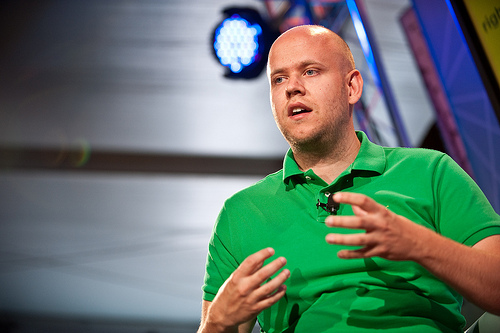What’s the secret to staying fresh, lean and mean when you’re a hot tech company on a fast growth trajectory? A fascinating document brought to our attention today today by Andrew Mager, hacker advocate at Spotify, answers that question in some detail by telling us how the music streaming juggernaut does it: by dividing up its business into small clusters — which it calls ‘squads’ — and running each like a startup in its own right. We’ve embedded the document below.
The information here is all the more relevant since this week we saw that Spotify is now finally making a move on to the web. When that is fully live, it could open Spotify up to another big growth boom from a whole new population of users beyond the 15 million early adopters (4 million of which pay) who currently use its mobile and desktop clients.
Written by Henrik Kniberg, an agile development consultant with Crisp, and Anders Ivarsson, an agile coach at Spotify, the document details how the company has restructured its organization over the last year to help the company scale better.
It’s also a nice complement to another insight into startup scaling we came across some months ago, from Mike Krieger, co-founder of Instagram.
At Spotify, to start with, the smallest grouping unit is called a squad. At present, there are 30 squads, covering 250 people in all in three countries — and each behaves like a lean startup in its own right.
Each focuses on a specific function — say, radio — and iterates on minimum viable product, releasing updates early and often. Those squads, it notes, have their own workspaces, and flat management structures, although each has a product ‘owner’, too, who leads on making connections with other squads. That has its pros and cons it seems:
“Ideally each squad is fully autonomous with direct contact with their stakeholders, and no blocking dependencies to other squads. Basically a mini-startup. With over 30 teams, that is a challenge! We have come a long way, but there are still plenty of improvements to be made.
The interaction between those smaller groups is done by way of three other structures. Related squads are grouped into tribes — say infrastructure, or music player tribes. These behave as “incubators” for the startup-like squads. Kniberg and Ivarsson say that tribes will never have more than 100 people, to keep them small and agile.
Tribes, too, attempt to remain autonomous of each other, although because there is some clear interaction needed between them, especially for specific projects, they do. Grouping together for projects is called “creating scrums.” Like in sport Rugby.
For further working together and communication, there are larger groupings, called chapters and guilds, which are detailed more in the document below.
There are definitely some ups and downs to this method of working.
Introduced over the past year, “people are still getting used to it,” the authors note tersely. (They don’t mention what parts are harder to do than others, but perhaps one part is the flatness of the structure and how that might impact prioritizing one thing over another; or whether regular meetings and assessments ever get in the way of just keeping your head down and working.) But they also point out that in the regular surveys they carry out — also part of the agile working process — they have found that “Despite the fast growth [of Spotify] employee satisfaction has continuously increased; in April 2012 it was 4.4 out of 5.”
Spotify, led by CEO Daniel Ek (pictured), is having a bumper 2012 so far. We’ve heard revenues could be as high as $500 million this year as it moves closer to profitability, and continues to expand to new markets. As of this week, Spotify is now live in 17 countries.
Image: Flickr
